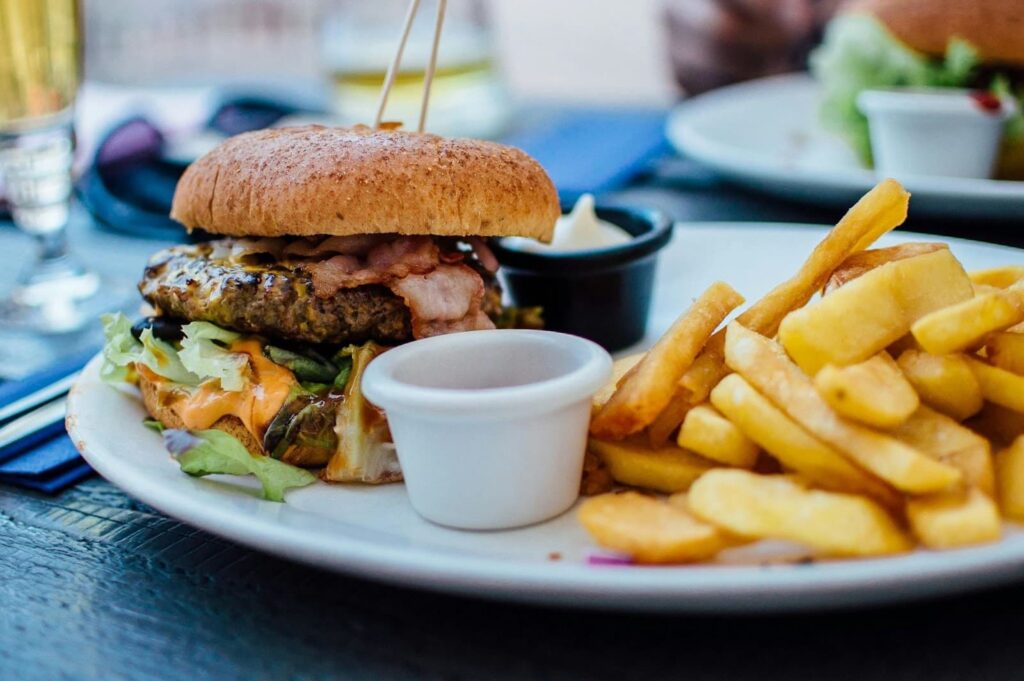Few foods are as instantly recognizable and universally loved as the hamburger. Whether it’s a gourmet Wagyu beef burger with truffle aioli or a simple roadside classic wrapped in wax paper, the hamburger has cemented itself as the quintessential American fast food. But how did this humble sandwich, originally just ground beef between two pieces of bread, become an undisputed icon of American culture? The answer lies in a mix of innovation, convenience, and a deep cultural connection that has made the burger more than just food—it’s an experience.
The Origins: From Germany to American Diners
Although Americans proudly claim the hamburger as their own, its roots trace back to Europe—specifically, to the port city of Hamburg, Germany. In the 19th century, German immigrants brought with them a dish known as the Hamburg steak, which consisted of seasoned ground beef, typically served without a bun. It was filling, affordable, and easy to prepare, making it a favorite among working-class communities.
But the real revolution happened in the United States, where inventive cooks transformed the Hamburg steak into a portable, bun-wrapped meal. While several stories exist about the first true hamburger, one of the most popular claims comes from Louis Lassen, a Danish immigrant who ran a small lunch wagon in New Haven, Connecticut. In 1900, a hurried customer asked for something quick to eat, and Lassen reportedly placed a Hamburg steak between two slices of bread—giving birth to the American hamburger.
The Rise of the Fast-Food Burger
The hamburger might have remained a local specialty if not for the rise of fast food chains in the 20th century. What set the hamburger apart was not just its taste but its convenience—it was the perfect food for America’s fast-paced, industrializing society. Key Moments in the Hamburger’s Popularity:

- 1921 – The Birth of White Castle: White Castle, founded in Kansas, became the first fast-food hamburger chain, marketing burgers as clean, safe, and affordable for the working class.
- 1940 – McDonald’s Changes the Game: The McDonald brothers introduced a speedy service system that would define the modern fast-food industry, making burgers faster, cheaper, and more accessible than ever before.
- 1950s-1960s – The Drive-Thru Boom: As car culture exploded, drive-thru burger joints like In-N-Out Burger and Burger King emerged, solidifying the hamburger’s place as a must-have meal for road trips.
- Modern Day – The Gourmet Burger Movement: From Shake Shack to Five Guys, a new wave of burger joints emphasized fresh ingredients, customization, and high-quality beef, proving that fast food and quality could coexist.
Hamburger Popularity Over the Years
| Year | Major Event | Impact on Burger Popularity |
|---|---|---|
| 1900 | Louis Lassen creates the first hamburger | Establishes the concept of a sandwich-style beef patty |
| 1921 | White Castle is founded | First fast-food burger chain, making burgers widely available |
| 1948 | McDonald’s introduces “Speedee Service System” | Fast, uniform burgers become the industry standard |
| 1950s-60s | Drive-thru culture grows | Burgers become the ultimate American road trip meal |
| 2000s | The rise of gourmet burger chains | Shows that burgers can be both fast food and high-end cuisine |
Why Do Americans Love Hamburgers So Much?
There’s no single reason why the hamburger is so beloved, but several factors have contributed to its legendary status:
- It’s Versatile – Burgers can be cheap or gourmet, stuffed with cheese, topped with bacon, or even made vegetarian.
- It’s Convenient – A burger is easy to eat on the go, perfect for fast-paced American lifestyles.
- It’s Nostalgic – Many Americans have childhood memories of eating burgers at diners, cookouts, or fast-food restaurants.
- It’s a Symbol of America – Just like apple pie, the burger has become a cultural icon, representing American innovation and simplicity.
- It’s Delicious – Let’s be honest: the combination of juicy beef, soft bun, melted cheese, and crisp toppings is irresistible.
More Than Just a Sandwich
The hamburger’s rise to dominance wasn’t just about taste—it was about adapting to the times. It went from a working-class meal to a fast-food staple, and today, it continues to evolve with healthier options, gourmet twists, and even plant-based alternatives. Despite all these changes, one thing remains the same: the hamburger is more than just a meal—it’s a symbol of American culture, history, and innovation.
So next time you bite into a burger, think about the journey it took to get there—from a Hamburg steak to a McDonald’s drive-thru, to the gourmet restaurants redefining fast food today. What will the next chapter of the burger’s story be?
FAQs
Why did hamburgers become more popular than hot dogs in America?
Because burgers are more customizable, easier to mass-produce, and have a more diverse range of flavors and textures.
What’s the secret to making the perfect homemade burger?
Use high-quality ground beef (preferably 80/20), season simply, and cook on high heat for a flavorful crust.
What is the most expensive hamburger ever made?
The “Golden Boy” burger from the Netherlands, costing over $5,000, is made with Wagyu beef, truffle-infused cheese, and edible gold leaf.